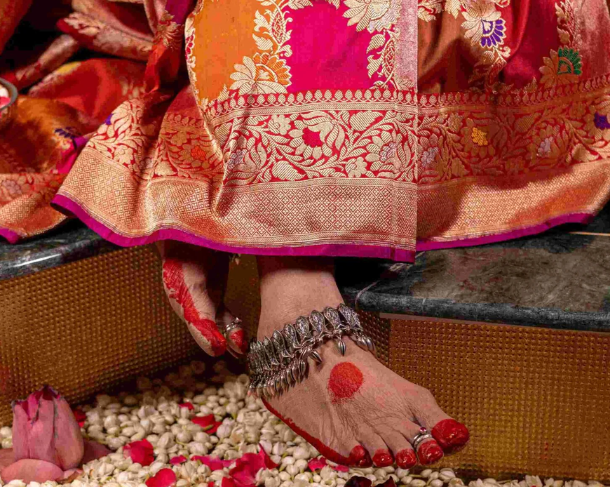The roots of the Banarasi saree trace back to the Vedic period, but it was during the Mughal era that this art form truly flourished. Inspired by Persian aesthetics and nurtured by Indian craftsmanship, Banaras (now Varanasi) became the beating heart of this intricate weave. Under the patronage of Mughal emperors, artisans mastered the delicate brocade technique, where gold and silver threads were woven into the finest silk, creating patterns that exuded opulence and grandeur.
Through centuries, this artistry has been carefully preserved, with families dedicating their lives to the meticulous hand-weaving of Banarasi sarees. Every drape embodies hours of labor, patience, and a deep reverence for tradition, making each saree an exquisite masterpiece.
In Hindu traditions, Banarasi sarees are often associated with rituals and sacred ceremonies. The sacred city of Varanasi, known for its spiritual significance, lends an aura of sanctity to these weaves, making them an essential part of religious festivities and weddings. When a woman drapes a Banarasi saree, she carries with her the essence of history, the touch of artisans’ hands, and the soul of a civilization that values beauty and craftsmanship above all else.
Even in today’s fast-paced world, where fashion is fleeting, the Banarasi saree stands unshaken an eternal emblem of grace. Celebrities, designers, and brides across the world revere this fabric for its regal charm and unparalleled craftsmanship. It is not just an attire but an experience one that evokes pride in its wearer and admiration in those who behold it.
A Banarasi saree is more than fabric it is history, emotion, and artistry entwined. It represents the confluence of devotion and beauty, of time-honored traditions and modern-day elegance. To own one is to hold a piece of India’s soul, a shimmering testament to the skill, passion, and dreams of generations of weavers.
So, the next time you see a Banarasi saree, know that it is not just a weave; it is a whispered tale of an artist’s love, a bride’s dream, and a culture’s pride an eternal drape that will never lose its magic.
As we transcend across India this beautiful peace of craftsmenship takes different forms
1. Traditional Nivi Style (Most Common)
How to Drape:
Start by tucking one end into the petticoat and wrapping it around the waist once . Create pleats (6-8) in the front and tuck them in neatly. Ring the pallu over the left shoulder, leaving it open or pleated.
How to Style:
Pair with a contrast blouse (deep red, green, or gold).
Adorn with traditional temple jewelry and a bindi.
Opt for a sleek bun with gajra (flower garland) for a classic look.
2. Gujarati Style (Seedha Pallu)
How to Drape:
Follow the Nivi style till pleats are tucked in.Instead of letting the pallu fall at the back, bring it over the right shoulder and drape it across the front.
How to Style:
Ideal for festivals and pujas.
Style with heavy jhumkas and bangles for a traditional appeal.
Add a statement waist belt (kamarbandh) for an elegant touch.
3. Bengali Style (Atpourey Draping)
How to Drape:
Unlike the Nivi style, this style does not require pleats in the front. Wrap the saree around the waist twice.The pallu is then brought over the left shoulder and pinned. The other end of the pallu is pleated and tucked at the waist in the front.
How to Style:
Best paired with a puff-sleeved or elbow-length blouse.
Add a large red bindi and gold bangles for an authentic Bengali look.
Opt for a middle-parted bun adorned with flowers.
4. Maharashtrian Nauvari Style (9-Yard Saree Draping)
How to Drape:
The saree is worn like a dhoti, wrapping around the legs to allow free movement.The pallu is draped over the left shoulder or tucked at the waist.
How to Style:
Perfect for traditional Marathi functions or dance performances. Pair with a nath (nose ring), green bangles, and a half-moon bindi. Style hair in a braided bun with mogra flowers.t's time to take your sarees out of the closet and give them a fresh spin! Drape them in your unique style and make a statement.




